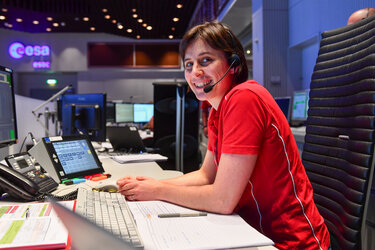Hear from Xanthi Oikonomidou, YGT for Space Debris
Want to learn more about the various exciting projects YGTs are working on today? We’ve gathered several YGTs to give us the inside scoop of what a day in the life of an ESA YGT is all about.
Tell us a little about yourself
My name is Xanthi Oikonomidou and I am a YGT at the Space Debris Office at ESOC/ESA in Darmstadt, Germany. I am half-Greek, half-Cypriot, but I have spent most of my life in Greece, where I obtained my Bachelor’s and Master’s degrees in Rural and Surveying Engineering with a specialisation in Satellite Geodesy from the Aristotle University of Thessaloniki (AUTH). I completed my second Master’s in Earth Oriented Space Science and Technology at the Technical University of Munich (TUM). Since December 2018, I have been working as a research assistant at the Institute of Astronomical and Physical Geodesy at the Technical University of Munich and in October 2020, I joined the Space Debris Office (SDO) at ESOC. My current interests include the modelling of the small space debris population, the in-situ space debris detection and the detection of satellite and debris streaks in space images.

What encouraged you to apply to become an ESA YGT?
The main reasons I decided to apply as an ESA YGT were my interest in the space debris field and the positive feedback I received from former ESA YGTs. I became interested in the topic of space debris during an orbital mechanics lecture, during which were displayed a scary graph depicting the evolution of space debris in Earth orbit and a picture of the Earth with two characteristic rings around it. That lecture was the driving factor for me to start researching and trying to work further with space debris through various student projects. Since 2017 I have been working with a CubeSat design team, building a satellite capable of obtaining useful in-situ measurements from space debris impactors. In 2018 I attended ESA’s Space Debris training workshop, when I also learnt more about the ESA YGT opportunities. Former YGTs confirmed that the programme offers an invaluable working experience and of course gives you the chance to learn and work directly with experts in your field. So, when I saw the opening for the YGT position for Space Debris, I had no second thoughts about applying.
What does your role at ESA entail?
I am currently involved in several projects and activities, all related to the field of space debris. I recently took on the role of Project Manager for a small activity called DMF-04 (Debris Mitigation Facility – 04), for which we utilised observations of small space debris and meteoroids from in-situ space debris detectors, with the aim of updating the corresponding size regimes in ESA’s MASTER (Meteoroid and Space Debris Terrestrial Environment Reference) model. I am also involved in an activity that deals with the generation of the simulation population for MASTER, as well as in projects that concern the verification of space debris mitigation guidelines related to risk assessment and spacecraft re-entry. I am also writing and maintaining a code chain for the processing of space images, which would then allow the detection of satellite or space debris streaks captured in the images.

What is working at ESA like, for you?
Working at ESA has been an extraordinary experience so far! The environment is international and multicultural, which creates a creative and productive atmosphere. I feel that the contribution of trainees and interns is greatly appreciated and this has definitely contributed to me being very motivated and wanting to support my team. ESA additionally offers very good employment conditions and flexible working hours. All in all, the ESA experience has exceeded my expectations.
Which ESA establishment are you located at?
I am located at ESOC, the European Space Operations Centre, in Darmstadt, Germany. ESOC serves as the main mission control centre for the European Space Agency. Darmstadt is known as the ‘’City of Science’’ and it is home to many well-known research institutions and universities including GSI, Fraunhofer, ESOC and EUMETSAT. The atmosphere here is youthful, vibrant and quite international, as lots of students and young families from various parts of the world live in the city.
What is your best memory so far as a YGT?
My best memory so far has been the first ESA MASTER modelling workshop, in March 2021. The three-day virtual workshop was organised by ESA’s Space Debris Office (SDO), in cooperation with Michael Clormann from the TUM’s Centre for Technology in Society (MCTS). The objective of the workshop was to discuss space debris modelling aspects with stakeholders and to understand the needs and relations between the different groups and the improvement of stakeholder involvement in areas related to space debris modelling. More than 80 participants from all around the world joined us. My participation in organising and moderating a successful event and the interest and support that all participants showed are definitely things I will remember from my traineeship.

What has been the biggest challenge for you?
Similar to many other trainees who took up duty between 2020 and 2022, the Covid-19 restrictions did not allow me to spend much time on-site. While the regulations are being updated every month based on the current pandemic situation, the norm since I started working at ESOC has been teleworking from home. I therefore did not have the chance to meet some of my colleagues in person. I was concerned that feeling part of the team and working efficiently might be difficult, especially given the limited time of the traineeship. While that did seem to be the biggest challenge in the beginning, my team has been more than supportive and my experience so far has been great!
What advice do you have for future YGT applicants?
My advice to all future YGT applicants is simple: allocate sufficient time to prepare a motivation letter that represents you and your experiences, always related to the topic you are applying for. Preparing for the online interviews definitely helps reduce stress before and during the interviews. Dedicate some time to learning more about ESA, the way the Agency operates and the activities and projects that the department you are applying for is involved with. But most importantly: be yourself! Do not be afraid to show your enthusiasm or ask questions during the interviews!
And to all successful YGT applicants: the YGT traineeship is a unique experience, but as it happens with all good things, time might feel like it is flying. So my advice there would be: try to make the most of it from your first day as a YGT! Connect with your colleagues, network and communicate, support your team by getting involved in various projects, keep learning and do not let opportunities slip away.
Hear from YGTs
Want to learn more about the work ESA YGTs are doing today? Keep reading about other YGTs and their exciting projects in this two-part article (part one and part two).
How do I apply for a YGT opportunity?
- Explore our Young Graduate Trainee opportunities here.
- Select the one opportunity that genuinely interests you and fits best with your educational background. Due to the high number of applications received each year, we can only accept a maximum of two applications per person. Should you apply to more vacancies, all your applications will be disregarded. If your profile is of interest for another position, we will share it with the hiring manager.
- Register and create your candidate profile with your CV and motivation letter.
- Apply! You will be able to track the status of your application throughout the process.
Learn more about the YGT Programme.










